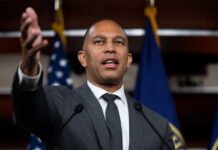As recent financial studies show, Americans are increasingly struggling with credit card debt and other loans and paying more for basic banking services such as ATM withdrawals.
Interest and fees on credit card accounts with balances rose about 25 percent in 2023 from a year earlier, according to a report released this month by the Financial Health Network, a nonprofit focused on financial stability. And 42 percent of households with balances on credit cards said their overall debt levels were “unmanageable,” up from 38 percent in 2022, the network found.
“The upward trend is setting off alarm bells,” says Hannah Gdalman, financial services manager at the nonprofit. More and more borrowers are falling behind on their credit card payments, especially those who have already maxed out their cards, according to the Federal Reserve Bank of New York. The average interest rate on credit cards with interest is nearly 23 percent, so balances can quickly balloon.
Paying off credit cards, as well as auto loans, student loans and other installment loans, is becoming increasingly difficult for consumers, the financial network found. People the network considers “financially vulnerable” — a classification of people who say they have trouble paying bills on time, saving for emergencies and managing debt — account for a disproportionate share of spending on interest and fees related to credit products, the report found. (The analysis, which the network publishes annually, is based on public data and a nationally representative consumer survey.)
Separately, the National Foundation for Credit Counseling, a nonprofit whose members help people deal with credit card and other unsecured debt, warned of a rise in financial problems among consumers based on data from its counseling centers. The foundation's latest stress forecast, an index designed to predict how likely people are to make their loan and credit card payments, had fallen since late last year, suggesting that people are more confident about meeting their obligations. But it is expected to rise by about 10 percent in the third quarter.
Bruce McClary, a spokesman for the foundation, said inflation has cooled but prices for some basic goods remain high, prompting cash-strapped consumers to take out loans to meet their needs. “People are still struggling,” he said.
There are steps you can take if your credit card debt keeps growing. First, call your bank and ask them to lower the interest rate on your card so your balance doesn't grow as quickly, recommends Todd Christensen, director of education at Money Fit, a nonprofit credit counseling agency.
If you still have good credit, you could apply for a card with a 0 percent transfer offer and transfer the debt to the new account, said Alvin Carlos, a financial planner in Washington. But make sure you can pay off the debt during the promotional period, or you'll be back to paying double-digit interest when the term ends. A personal loan with a lower interest rate — say 12 to 15 percent — is another alternative.
If those options don't work, you could check the interest rates on your own credit cards – most people have several – and transfer your debt to the card with the lowest interest rate to curb monthly finance costs, advises Brandy Baxter, a Dallas-based financial advisor.
Often, people's income is simply not enough to cover their living expenses, so they turn to credit cards to ease the financial squeeze, Ms Baxter says. “But this actually adds to the pressure,” she says, as double-digit interest rates are incurred.
Ms. Baxter reviews expenses with her clients to see if they have any money left over that they could use to pay off debt, she said. If not, she would suggest they look for ways to increase their income, at least temporarily, by working more hours or taking on a side job and using the extra money to pay off credit card debt.
Gregg Murset, a financial planner and CEO of BusyKid, a finance app for kids, said some people have sufficient income but accumulate credit card debt because they spend so much money, as if they were earning much more. “Don't pretend you're rich if you're not,” he said.
That might mean taking fewer vacations or eating out at fine restaurants. He also urged parents to think about whether they should continue to pay their adult children's expenses, such as a cell phone bill or car insurance, rather than spending the money to pay off their own debts.
“Stop paying for other people’s things,” said Mr Murset.
Daphne Jordan, president of the National Association of Personal Financial Advisors, a fee-only group of financial advisers, recommends the “avalanche method” of debt reduction. It involves finding the credit card with the highest interest rate and putting extra money toward that balance until it's paid off in full. At the same time, keep paying more than the minimum payments on your other cards to keep those balances from ballooning, she recommends.
When the card with the highest interest rate is paid off, you can apply the money you paid to the card with the next highest interest rate, and so on. A free online tool, PowerPay from Utah State University Extension, can help you get started, she said.
In addition to debt, bank fees can increase consumers' financial burden. Household spending on ATM fees rose an estimated 25 percent from 2020 to 2023, the Financial Health Network found, while spending on account maintenance fees – monthly service charges for maintaining an account – rose about 20 percent.
Financial website Bankrate reported this week that the cost of using out-of-network ATMs has risen to an average of nearly $5 per transaction, the highest since the website began tracking fees in 1998. The total cost includes the fees charged by the customer's main bank as well as the fees charged by the bank that owns the ATM (the report covered 245 banks).
Fewer and fewer people are using out-of-network ATMs to withdraw cash, says Greg McBride, chief financial analyst at Bankrate, so banks are charging higher fees to compensate.
Most banks have apps that show the location of their ATMs, so you can see if there's one near you while you're on the go. If you're shopping at a local bank with limited ATMs, find out if it participates in a nationwide fee-free network, like Allpoint, McBride said. Another option: Get fee-free cash back when you pay at stores with your debit card.
Here are some questions and answers about dealing with debt and bank fees:
Where can I get help managing my credit card debt?
If you need assistance, you can contact a nonprofit credit counseling agency. (You can search for one on the National Foundation for Credit Counseling website.) These groups can help you work out a debt settlement plan with your creditors that will lower your interest rate in exchange for agreeing to pay off your debt, which is usually in four to five years. (The agency may charge a fee to administer the plan, but this can be reduced or waived if doing so would create a hardship.)
Seek help early — as soon as you start having trouble making more than the required minimum payments on your cards — to maximize your options, McClary advised.
Which apps can help me avoid overspending?
Mint, the popular free budget app, has been discontinued, but there are alternatives, albeit with subscription fees. Mr. Carlos recommends Monarch Money, which charges an annual fee of about $100 (higher if you pay monthly). For other options, see a list by New York Times columnist Ron Lieber.
What happens to overdraft fees?
One bright spot for bank customers in recent years has been the decline in overdraft fees, which are charged when a bank clears a debit or check even though the account doesn't have enough money. Some banks, under pressure from regulators, have eliminated the fees. But Bankrate found that overdraft fees have started to rise again, up nearly 2 percent to an average of about $27. If you have direct deposit set up for your paycheck, some banks will give you early access to the funds to offset overdrafts within two days of the deposit, McBride said. Ask your bank if that's an option.














